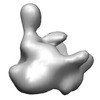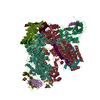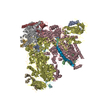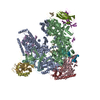+ データを開く
データを開く
- 基本情報
基本情報
| 登録情報 | データベース: EMDB / ID: EMD-2194 | |||||||||
|---|---|---|---|---|---|---|---|---|---|---|
| タイトル | human RNA Polymerase II | |||||||||
 マップデータ マップデータ | human Pol II | |||||||||
 試料 試料 |
| |||||||||
 キーワード キーワード | transcription regulation / RNA polymerase II / non-coding RNA | |||||||||
| 生物種 |  Homo sapiens (ヒト) Homo sapiens (ヒト) | |||||||||
| 手法 | 単粒子再構成法 / クライオ電子顕微鏡法 / 解像度: 25.0 Å | |||||||||
 データ登録者 データ登録者 | Kassube SA / Fang J / Grob P / Yakovchuk P / Goodrich JA / Nogales E | |||||||||
 引用 引用 |  ジャーナル: J Mol Biol / 年: 2013 ジャーナル: J Mol Biol / 年: 2013タイトル: Structural insights into transcriptional repression by noncoding RNAs that bind to human Pol II. 著者: Susanne A Kassube / Jie Fang / Patricia Grob / Petro Yakovchuk / James A Goodrich / Eva Nogales /  要旨: Gene transcription is regulated in response to environmental changes and developmental cues. In mammalian cells subjected to stress conditions such as heat shock, transcription of most protein-coding ...Gene transcription is regulated in response to environmental changes and developmental cues. In mammalian cells subjected to stress conditions such as heat shock, transcription of most protein-coding genes decreases, while the transcription of heat shock protein genes increases. Repression involves direct binding to RNA polymerase II (Pol II) of certain noncoding RNAs (ncRNAs) that are upregulated upon heat shock. Another class of ncRNAs is also upregulated and binds to Pol II but does not inhibit transcription. Incorporation of repressive ncRNAs into pre-initiation complexes prevents transcription initiation, while non-repressive ncRNAs are displaced from Pol II by TFIIF. Here, we present cryo-electron microscopy reconstructions of human Pol II in complex with six different ncRNAs from mouse and human. Our structures show that both repressive and non-repressive ncRNAs bind to a conserved binding site within the cleft of Pol II. The site, which is also shared with a previously characterized yeast aptamer, is close to the active center and, thus, in an ideal position to regulate transcription. Importantly, additional RNA elements extend flexibly beyond the docking site. We propose that the differences concerning the repressive activity of the ncRNAs analyzed must be due to the distinct character of these more unstructured, flexible segments of the RNA that emanate from the cleft. | |||||||||
| 履歴 |
|
- 構造の表示
構造の表示
| ムービー |
 ムービービューア ムービービューア |
|---|---|
| 構造ビューア | EMマップ:  SurfView SurfView Molmil Molmil Jmol/JSmol Jmol/JSmol |
| 添付画像 |
- ダウンロードとリンク
ダウンロードとリンク
-EMDBアーカイブ
| マップデータ |  emd_2194.map.gz emd_2194.map.gz | 6.2 MB |  EMDBマップデータ形式 EMDBマップデータ形式 | |
|---|---|---|---|---|
| ヘッダ (付随情報) |  emd-2194-v30.xml emd-2194-v30.xml emd-2194.xml emd-2194.xml | 18.5 KB 18.5 KB | 表示 表示 |  EMDBヘッダ EMDBヘッダ |
| 画像 |  emd_2194.png emd_2194.png | 42.9 KB | ||
| アーカイブディレクトリ |  http://ftp.pdbj.org/pub/emdb/structures/EMD-2194 http://ftp.pdbj.org/pub/emdb/structures/EMD-2194 ftp://ftp.pdbj.org/pub/emdb/structures/EMD-2194 ftp://ftp.pdbj.org/pub/emdb/structures/EMD-2194 | HTTPS FTP |
-検証レポート
| 文書・要旨 |  emd_2194_validation.pdf.gz emd_2194_validation.pdf.gz | 187.2 KB | 表示 |  EMDB検証レポート EMDB検証レポート |
|---|---|---|---|---|
| 文書・詳細版 |  emd_2194_full_validation.pdf.gz emd_2194_full_validation.pdf.gz | 186.3 KB | 表示 | |
| XML形式データ |  emd_2194_validation.xml.gz emd_2194_validation.xml.gz | 5.4 KB | 表示 | |
| アーカイブディレクトリ |  https://ftp.pdbj.org/pub/emdb/validation_reports/EMD-2194 https://ftp.pdbj.org/pub/emdb/validation_reports/EMD-2194 ftp://ftp.pdbj.org/pub/emdb/validation_reports/EMD-2194 ftp://ftp.pdbj.org/pub/emdb/validation_reports/EMD-2194 | HTTPS FTP |
-関連構造データ
- リンク
リンク
| EMDBのページ |  EMDB (EBI/PDBe) / EMDB (EBI/PDBe) /  EMDataResource EMDataResource |
|---|
- マップ
マップ
| ファイル |  ダウンロード / ファイル: emd_2194.map.gz / 形式: CCP4 / 大きさ: 7.8 MB / タイプ: IMAGE STORED AS FLOATING POINT NUMBER (4 BYTES) ダウンロード / ファイル: emd_2194.map.gz / 形式: CCP4 / 大きさ: 7.8 MB / タイプ: IMAGE STORED AS FLOATING POINT NUMBER (4 BYTES) | ||||||||||||||||||||||||||||||||||||||||||||||||||||||||||||||||||||
|---|---|---|---|---|---|---|---|---|---|---|---|---|---|---|---|---|---|---|---|---|---|---|---|---|---|---|---|---|---|---|---|---|---|---|---|---|---|---|---|---|---|---|---|---|---|---|---|---|---|---|---|---|---|---|---|---|---|---|---|---|---|---|---|---|---|---|---|---|---|
| 注釈 | human Pol II | ||||||||||||||||||||||||||||||||||||||||||||||||||||||||||||||||||||
| 投影像・断面図 | 画像のコントロール
画像は Spider により作成 | ||||||||||||||||||||||||||||||||||||||||||||||||||||||||||||||||||||
| ボクセルのサイズ | X=Y=Z: 3.01 Å | ||||||||||||||||||||||||||||||||||||||||||||||||||||||||||||||||||||
| 密度 |
| ||||||||||||||||||||||||||||||||||||||||||||||||||||||||||||||||||||
| 対称性 | 空間群: 1 | ||||||||||||||||||||||||||||||||||||||||||||||||||||||||||||||||||||
| 詳細 | EMDB XML:
CCP4マップ ヘッダ情報:
| ||||||||||||||||||||||||||||||||||||||||||||||||||||||||||||||||||||
-添付データ
- 試料の構成要素
試料の構成要素
+全体 : human Pol II
+超分子 #1000: human Pol II
+分子 #1: Rpb12
+分子 #2: Rpb11
+分子 #3: Rpb10
+分子 #4: Rpb9
+分子 #5: Rpb8
+分子 #6: Rpb7
+分子 #7: Rpb6
+分子 #8: Rpb5
+分子 #9: Rpb4
+分子 #10: Rpb3
+分子 #11: Rpb2
+分子 #12: Rpb1
-実験情報
-構造解析
| 手法 | クライオ電子顕微鏡法 |
|---|---|
 解析 解析 | 単粒子再構成法 |
| 試料の集合状態 | particle |
- 試料調製
試料調製
| 濃度 | 0.0312 mg/mL |
|---|---|
| 緩衝液 | pH: 7.9 詳細: 10 mM Tris pH 7.9, 10 mM HEPES pH 8.0, 4 mM MgCl2, 50 mM KCl, 0.05% NP-40, 1 mM DTT, 0.1% trehalose |
| グリッド | 詳細: 400 mesh C-flat grids (Protochips Inc.) with a thin carbon film floated on top |
| 凍結 | 凍結剤: ETHANE / チャンバー内湿度: 100 % / チャンバー内温度: 86 K / 装置: FEI VITROBOT MARK II / 手法: 6 sec blot, offset -2 |
- 電子顕微鏡法
電子顕微鏡法
| 顕微鏡 | FEI TECNAI 20 |
|---|---|
| 温度 | 平均: 78 K |
| アライメント法 | Legacy - 非点収差: Objective lens astigmatism was corrected at 100,000 times magnification |
| 日付 | 2011年7月10日 |
| 撮影 | カテゴリ: CCD フィルム・検出器のモデル: GENERIC GATAN (4k x 4k) デジタル化 - サンプリング間隔: 1.5 µm / 実像数: 972 / 平均電子線量: 20 e/Å2 / 詳細: data collected with leginon |
| 電子線 | 加速電圧: 120 kV / 電子線源:  FIELD EMISSION GUN FIELD EMISSION GUN |
| 電子光学系 | 照射モード: FLOOD BEAM / 撮影モード: BRIGHT FIELD / Cs: 2.2 mm / 最大 デフォーカス(公称値): 3.0 µm / 最小 デフォーカス(公称値): 1.2 µm / 倍率(公称値): 80000 |
| 試料ステージ | 試料ホルダー: Side-entry cryostage / 試料ホルダーモデル: GATAN LIQUID NITROGEN |
- 画像解析
画像解析
| CTF補正 | 詳細: whole micrograph |
|---|---|
| 最終 再構成 | 想定した対称性 - 点群: C1 (非対称) / アルゴリズム: OTHER / 解像度のタイプ: BY AUTHOR / 解像度: 25.0 Å / 解像度の算出法: FSC 0.5 CUT-OFF / ソフトウェア - 名称: EMAN2, FREALIGN 詳細: the data set was sorted into three different conformations using an automated multi-model approach; the initial reconstructions were used as starting models for multi-model projection ...詳細: the data set was sorted into three different conformations using an automated multi-model approach; the initial reconstructions were used as starting models for multi-model projection matching in EMAN2, followed by final refinement in FREALIGN 使用した粒子像数: 8905 |
 ムービー
ムービー コントローラー
コントローラー














 Z (Sec.)
Z (Sec.) Y (Row.)
Y (Row.) X (Col.)
X (Col.)





















